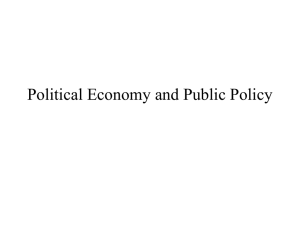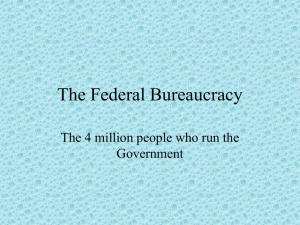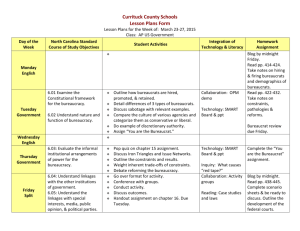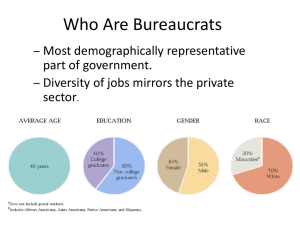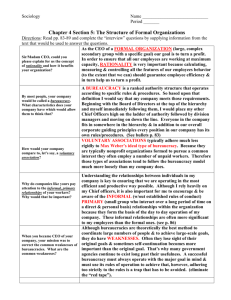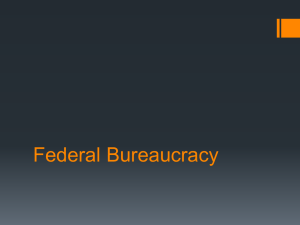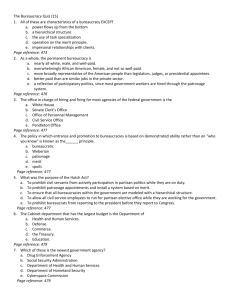Chapter 15
advertisement
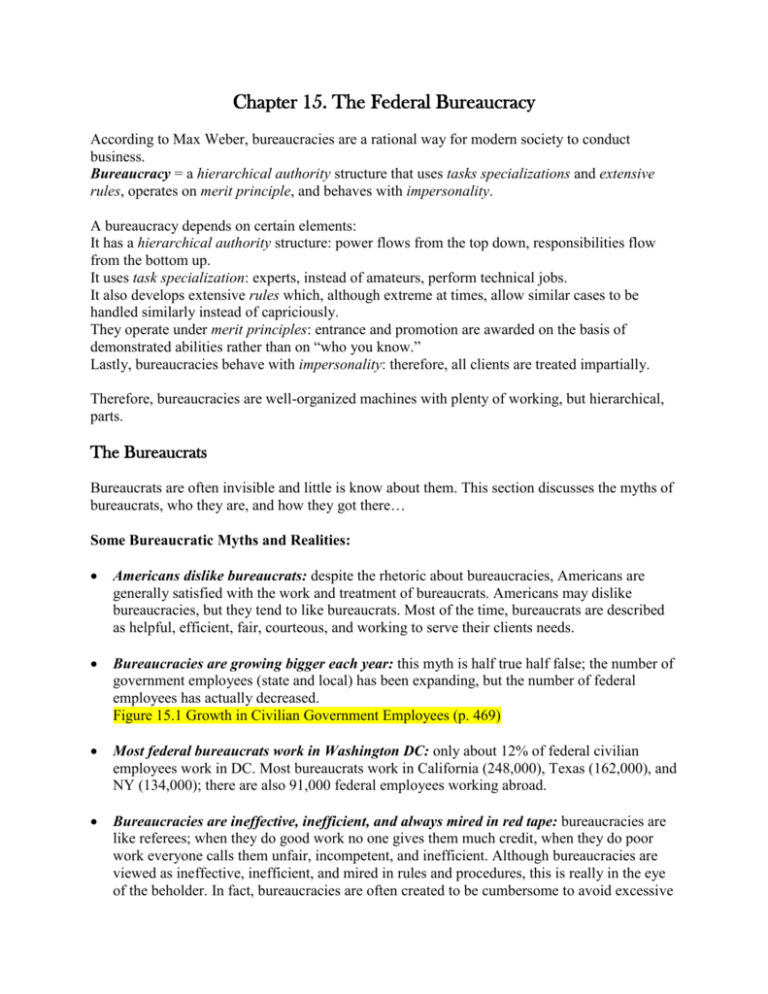
Chapter 15. The Federal Bureaucracy According to Max Weber, bureaucracies are a rational way for modern society to conduct business. Bureaucracy = a hierarchical authority structure that uses tasks specializations and extensive rules, operates on merit principle, and behaves with impersonality. A bureaucracy depends on certain elements: It has a hierarchical authority structure: power flows from the top down, responsibilities flow from the bottom up. It uses task specialization: experts, instead of amateurs, perform technical jobs. It also develops extensive rules which, although extreme at times, allow similar cases to be handled similarly instead of capriciously. They operate under merit principles: entrance and promotion are awarded on the basis of demonstrated abilities rather than on “who you know.” Lastly, bureaucracies behave with impersonality: therefore, all clients are treated impartially. Therefore, bureaucracies are well-organized machines with plenty of working, but hierarchical, parts. The Bureaucrats Bureaucrats are often invisible and little is know about them. This section discusses the myths of bureaucrats, who they are, and how they got there… Some Bureaucratic Myths and Realities: Americans dislike bureaucrats: despite the rhetoric about bureaucracies, Americans are generally satisfied with the work and treatment of bureaucrats. Americans may dislike bureaucracies, but they tend to like bureaucrats. Most of the time, bureaucrats are described as helpful, efficient, fair, courteous, and working to serve their clients needs. Bureaucracies are growing bigger each year: this myth is half true half false; the number of government employees (state and local) has been expanding, but the number of federal employees has actually decreased. Figure 15.1 Growth in Civilian Government Employees (p. 469) Most federal bureaucrats work in Washington DC: only about 12% of federal civilian employees work in DC. Most bureaucrats work in California (248,000), Texas (162,000), and NY (134,000); there are also 91,000 federal employees working abroad. Bureaucracies are ineffective, inefficient, and always mired in red tape: bureaucracies are like referees; when they do good work no one gives them much credit, when they do poor work everyone calls them unfair, incompetent, and inefficient. Although bureaucracies are viewed as ineffective, inefficient, and mired in rules and procedures, this is really in the eye of the beholder. In fact, bureaucracies are often created to be cumbersome to avoid excessive use of power, to foster proper implementation of policies, and to produce SOP which apply to all equally. Who They Are and How They Got There: there are over 21 million civilian, federal, and state and local employees. Because of their large numbers, bureaucrats are extremely diverse; they are composed of males and females, from all races and religions, spanning all levels of pay. Like other institutions, the federal government has been under pressure to expand the hiring of women and minorities. Although congress has ordered the recruitment and promotion of previously disadvantaged groups, women and non-Whites still cluster at the lower ranks of federal agencies. However, as a whole, bureaucracies are more representative of the American people than are legislators, judges, or presidential appointees in the executive branch. Figure 15.2 Characteristics of Federal Civilian Employees (p. 471) Civil Service: From Patronage to Protection: until 100 years ago, a person got a job with the government through the patronage system. Patronage = a hiring and promotion system based on political reasons rather than merit or competence; key inducement used by political machines; includes patronage job, promotion, or contract given for political reasons. 19th century presidents staffed government with friends and allies … “to the victory belong the spoils.” However, the spoils system in federal appointments came to an end thanks to a disappointed office seeker named Charles Guiteau. Guiteau helped end the spoils system of federal appointments in 1881 when he became frustrated with President James A Garfield for not giving him a job. Because he did not receive a patronage job, he shot and killed Garfield. Garfield was replaced by his VP Chester A Arthur, the Prince of Patronage. However, rather than encourage patronage jobs, Arthur surprised his critics by passed in the 1883 Pendleton Civil Service Act. 1883 Pendleton Civil Service Act = an Act that created a federal civil service so that hiring promotions would be based on merit rather than patronage. Civil Service = a system of hiring and promotion based on merit principles and the desire to create a nonpartisan government service. Merit Principles = the idea that hiring should be based on entrance exams and promotion ratings to produce administration by people with talent and skill. The Hatch Act also served to eliminate partisanship from civil service jobs. Hatch Act = 1939 and 1993, federal law prohibiting government employees from active participation in partisan politics while on duty. Employees with sensitive positions – i.e. national security – are also prohibited from engaging in any political duty (either on or off the clock). In terms of employment, the OPM (Office of Personnel Management) has been placed in charge of hiring for most federal agencies. OPM = the OPM has elaborate rules about hiring, promotions, working conditions, and firing. To get a civil service job, candidates must usually take a test (Civil Service Test). If they pass the test, their names are sent to agencies when jobs requiring their particular skills become available. The Rule of Three = For each open position, the OPM sends three names to the agency. Except under unusual circumstance, the agency must hire one of the three individuals. Each civil service job is assigned a GS rating. GS Rating (General Schedule) = a schedule for federal employees ranging from GS1 to GS18. Salaries are keyed to ratings and experience. The higher the GS, the higher the pay.] Table 15.3 GS Employment and Salaries At the very top of the civil service system (GS 16-18) is the cream of the crop, the SES. Senior Executive Services (SES) = an elite group of about 9,000 federal government managers who are mostly career officials but include some political appointees who do not require Senate confirmation. These executives earn high salaries and can be moved from one agency to the next as leadership needs change. SES was created through the 1978 Civil Service Reform Act. Once hired, and after a probation period, civil servants are protected by the civil service system; oftentimes, critics claim that they are too overprotected. In fact, firing incompetence is hard work. Recent studies show that more than one agency has decided to tolerate incompetence, assigning them trivial or no duties, rather than invest its resources in the nearly hopeless task of discharging them. Firing incompetent minorities, females, or elderly workers may be even more difficult than firing incompetent White young and middle-aged males because many often claim discrimination in their appeals. (Ex. SIUC, Ass Dean, apathetic civil servant support staff) The Other Route to Federal Jobs: Recruiting from the Plum Book: after administrative changes, Congress publishes the Plum Book; a book listing the top federal jobs available for direct presidential appointment. There are about 400 top policymaking posts in this list, in addition to 2,500 lesser positions. All incoming presidents conduct a nationwide talent search for qualified personnel. Presidents seek individuals who combine executive talent, political skills, and sympathy for policy positions similar to those of the administration. Often the president tries to include men and women, Whites and non-Whites, people from different regions, and party members who represent different interests. Some positions go to large campaign contributors (i.e. ambassadorships). Because these positions change with presidential turnover, few top officials stay long enough to know their own subordinates. In addition, administrative routines, budget cycles, and legal complexities are often new to them. Although Plum appointees may exhibit a great deal of power, they soon learn that they are dependent on senior civil servants who know more, have been with the agency longer, and will eventually outlast them. How Bureaucracies are Organized In order to study the organization of executive agencies, it is best to group them into four basic types – cabinet departments, regulatory agencies, government corporations, and independent executive agencies. The Cabinet Departments: each of the 15 cabinet departments is headed by a secretary (exception – Department of Justice headed by Attorney General). These secretaries are chosen by the president, with Senate approval. Each department manages specific policy areas and each has its own staff and budget. Each department has its own mission; therefore, each is organized differently. The real work of the department is done by the bureaus (aka service, office, administration…), which divide the work into more specialized areas. (Though not a Cabinet Dept, see EEOC chart) (Ex. Department of Homeland Security Organizational Chart) (Ex. Dep of State, Dep of the Treasury, Dep of Defense, Dep of Justice, Dep of Interior, Dep of Agriculture, Dep of Commerce, Dep of Labor, Dep of Transportation…) The Regulatory Agencies: sometimes called the alphabet soup of American government because most agencies are known in Washington by their initials. Independent Regulatory Agency = a government agency responsible for some sector of the economy, making and enforcing rules to protect the public interest. It also judges disputes over these rules. Most of these independent regulatory agencies are governed by a small commission, usually 5 to 10 members appointed by the president and confirmed by the senate for a fixed terms. Unlike cabinet officers and members of the president’s staff, regulatory commission members cannot be fired easily by the president. Interest groups consider the rule making by independent regulatory agencies very important. (Ex. EEOC – Equal Employment Opportunity Commission, FRB – Federal Reserve Board, NLRB – National Labor Relations Board, FCC – Federal Communications Commission, FTC – Federal Trade Commission, SEC – Securities and Exchange Commission) The Government Corporations: a government organization that, like a business corporation, provides a service that can be provided by the private sector and typically charges for its service. (Ex. US Postal Service vs UPS – United Parcel Service) Occasionally, the government takes over a “sick industry” and turns it into a government corporation (Ex. AMTRAK) The Independent Executive Agencies: all other government agencies that do not fall under cabinet departments, independent regulatory agencies, and government corporations. Their administrators are typically appointed by the president and serve at his will. NASA – National Aeronautics and Space Administration – agency that takes Americans to the moon and beyond. GSA – General Service Administration – the government’s landlord; handles building, supplies, and purchasing. NSF – National Science Foundation – the agency supporting scientific research. Bureaucracies as Implementers Today, bureaucracies are viewed as policy implementers. They take congressional, presidential, and judicial pronouncements and develop procedures and rules for implementing policy goals. Bureaucracies also manage the routine of government, from delivering mail to collecting taxes to training troops. What Implementation Means: public policies are rarely self-executing. Congress typically announces the goal of a policy in broad terms, sets up an administrative apparatus, and leaves the bureaucracy the task of working out the details of the program. In other words, the bureaucracy is left to implement the program. Policy Implementation = is the stage of policymaking between the establishment of a policy (passage of legislation, issuance of executive order, judicial rulings, regulatory rule…), and the consequences of the policy for the people whom it affects. At a minimum, policy implementation includes three goals: 1. Creating a new agency or assignment of a new responsibility to an old agency. 2. Translation of policy goal into operational rules and development of guidelines for the program. 3. Coordination of resources and personnel to achieve the intended goal. Why the Best Laid Plans Sometimes Flunk the Implementation Test: policies that people expect to work often fail. Implementation can break down for many reasons: Program Design: it is impossible to implement a policy based on a defective theoretical concept. Ex. Forming an agency which would land a man on the sun… we would spend $, time, energy, and efforts; hire staffers and experts; and request more money… yet the task will never be achieved. Lack of Clarity: congress tends to state broad policy goals in legislations, but leaves the implementation to the bureaucracy. Ex. Title IX of the Education Act of 1972: “No person in the US shall, on the basis of sex, be excluded from participating in, be denied benefits of, or be subjected to discrimination under any educational program or activity receiving federal financial assistance.” Controversy – are women allowed then to play football and basketball on co-ed teams? Or, are women allowed to form their own female-only football and basketball teams? Not only do they receive unclear policies, but they also receive contradictory policies. As noted by James Q Wilson, INS is suppose to keep illegal immigrants out, but allow in agricultural workers; they are suppose to carefully screen foreigners entering the country, yet make entry for foreign tourists easy; and they are charged with finding and expelling illegal aliens, but not if it means breaking up families, imposing hardships, violating civil rights, or depriving employment to low paid workers. Lack of Resources: many assume that bureaucracies have many resources, yet this is not always the case. We should not be looking at the size of a bureaucracy in terms of its budget and staff; instead, we should be asking if the budget and staff are enough to perform the task at hand. Although bureaucracies seem large, they often lack staff, training, funding, supplies, and equipment to fulfill their obligations. FDA – shortage of staff is causing delays in new AIDS drug testing Head Start Programs – because of a lack of funding, less children are helped than those who are actually eligible for aid. INS – lack personnel to track aliens who overstay their visas or engage in suspicious activities (i.e. taking flight lessons that do not include take-offs and landings) EPA – inadequately trained inspectors overlooked serious violations in the handling and storage of hazardous waste FBI – lacks computers at its headquarters which allow for multiple database searches (aviation and schools) FAA – lacks the proper personnel and equipment to direct the nation’s air traffic safely. Agencies may also lack the authority to meet their responsibilities. For example, FDA lacks the power to protect the public from dangerous drugs such as Halcion and Versed. The FDA does not conduct its own testing; instead it must rely on that provided by the manufacturer. When the information submitted seems suspicious, or it appears that information is withheld, the FDA cannot issue a subpoena to obtain all the data from the drug companies. Dep of Agriculture lacks the authority to close meat processing plants – even ones with serous violations of food safety standards. Administrative Route: when it comes to administrative matters, most bureaucrats follow SOPs (Standard Operating Procedures) when making every day decisions. SOPs = procedures used by bureaucrats to bring uniformity to complex organizations; uniformity improves fairness and makes personnel interchangeable. Standard rules save time; therefore, detailed manuals are written to cover as many particular situations as officials can anticipate. (IRS and their regulation bible – the Internal Revenue Code) (EEOC and SOPs for recording keeping, annual reports, filing complaints…) SOPs also bring uniformity to complex organizations. Justice is better served when rules are applied uniformly. (levying of fines for underpaying taxes) Uniformity also brings interchangeable personnel. (Soldiers can be sent to any location and they can still do their job by reviewing SOPs) Although routines – SOPs – are essential, they often times frustrate citizens who view them as “red tape.” These SOPs tend to become obstacles. (Ex: IL State Treasury, requiring original receipts from 10 years ago to get money you overpaid) In addition, although helpful, SOPs have not been written for every possible scenario. (Ex: in 1997, the GAO found violations in FAA inspection reports, but had no SOPs in place to determine whether these violations were ever corrected) Administrators’ Dispositions: when SOPs do not fit the case, administrative discretion is granted. Administrative Discretion = the authority of administrative actors to select among various responses to a given problem. (Ex: although the income tax code is massive and detailed, the IRS wields great discretion because the US economy is so complex and a multitude of tax situations are possible.) Because bureaucrats will inevitable exercise a great deal of discretion, controlling the use of this discretion is difficult. In addition, efforts by the government to limit discretion have resulted in greater obstacles to effective and efficient government. (Ex: during the Persian Gulf War, the air force put in a request for 6,000 Motorola commercial radio receivers. However, Motorola refused to do business with the air force because of a government requirement that required them to create a separate accounting and cost-controlling system to process the order. The only way for the US Air Force to get the much needed receivers was for Japan to buy them and donate them to the US.) Fragmentation: sometimes responsibility for a policy is dispersed among several units within the bureaucracy. (Ex: in the field of Welfare, the government has ten different departments and agencies administering more than 100 federal human service programs: Department of Health and Human Services – basic welfare grants to families Department of Housing and Urban Development – provides housing assistance Department of Agriculture – food stamp program Department of Labor – administers training programs and provides assistance in obtaining employment) The diffusion of responsibility makes the coordination of policies time consuming and difficult. This diffusion also makes it difficult to attack problems comprehensively. This brings us to an important question. if fragmentation is a problem, why not reorganize government? Congressional Committees = recognize that they will lose jurisdiction over agencies if they are merged with others. Interest Groups = do not want to give up their relationship with “their” agencies. Agencies = do not want to be submerged within an even larger bureaucratic unit. However, under the right conditions (i.e. 911), reorganization is possible. In 2001, a Democratic congress proposed a new Department of Homeland Security. In 2002, Bush concluded that the only way to overcome government fragmentation in homeland security was to create a new department combining many of the agencies listed in: Table 15.4 Departments and Agencies with Responsibilities for Border Security in 2002 (p. 488) (Compare with current Dept of Homeland Security Organizational Chart) Congress created the new department at the end of 2002, the largest reorganization of the federal government in half a century. Bureaucracies as Regulators Regulation = the use of government authority to control or change some practice in the private sector; these regulations pervade the daily lives of people and institutions. Although they are the most controversial task of bureaucracies, congress gives bureaucrats broad authority in the area of regulations. Regulations in the Economy and in Everyday Life: every day of our lives are subject to bureaucratic regulation. Almost all bureaucracies are in the regulatory business. Think of a typical day… If you listen to the radio, the station you are listening to must be licensed by the FCC. Whatever you end up eating throughout the day has undergone an inspection by the FDA; if this includes any meats, then your food was also inspected by the Food Safety and Quality Service of the US Department of Agriculture. If you decide to drink a cup of coffee or soft drink, the FDA has issued a warning regarding how caffeine causes birth defects in lab animals. If you drive to work, you had to bring it in at one point or another to pass an Emissions and Safety Test. You are also required to wear a seat belt because of mandates from the National Highway Traffic Safety Administration. If you use public transportation, the fees you pay are also the result of regulations. If you have kids or younger siblings, their toys were inspected by the Consumer Product Safety Commission. Almost all of your appliances have been subjected to safety testing. If you decide to wind down the day with a beer, the brewery where that beer was made has been carefully supervised by the Bureau of Alcohol, Tobacco, and Firearms. Federal, state, and local taxes were also collected when you purchased your beer. Regulations: How it Grew, How it Works: Between the founding of the nation and 1887, the federal government had almost no regulations. In 1887, the federal government created the Interstate Commerce Commission, and charged it with regulating railroads, their prices, and their services to farmers. Therefore, the ICC set the precedence for regulatory policymaking. Most agencies charged with regulation must: 1) Receive a grant of power and a set of directions from Congress. 2) Establish a set of rules and guidelines; guidelines are established with consolations with the people or industry being regulated. 3) The agency must have some means of applying and enforcing its rules and guidelines, either in court or through its own administrative procedures. Sometimes it waits for complaints to come to them (EEOC), sometimes it sends inspectors to the field (OSHA) Toward Deregulation: deregulation has become a fashionable term. Deregulation = the lifting of government restrictions on business, industry, and professional activities. The idea behind deregulation is that the number and complexity of regulatory policy have made regulation too complicated. They claim that the current regulatory system: Raises Prices: if the producers is faced with expensive regulations, the cost is transferred to the consumer. Hurts America’s Competitive Position Abroad: American products may cost more because regulations in other nations are less restrictive. Does Not Always Work Well: regulations may be difficult and cumbersome to enforce. Sometimes, they fail to obtain the results intended by Congress. Nonetheless, supporters of regulations claim that they are necessary. For instance, lax enforcement of environmental protection standards during the Reagan administration led to severe environmental damage. In addition, regulations provide Americans with many benefits including clean air, safe conditions for miners, increases in infant survival rates. Conclusion Americans rarely congratulate someone for being a good bureaucrat; bureaucrats are the scapegoats of American politics. Bureaucrats shape policies, they implement policies, and they establish regulations. Although they are not elected, bureaucracies are not necessarily undemocratic. Lastly, although many criticize the increasing size of government, the federal bureaucracy has not grown over the past two generations. Instead, it has gotten smaller… even if the country has grown and the public continues to make greater demands on government.


